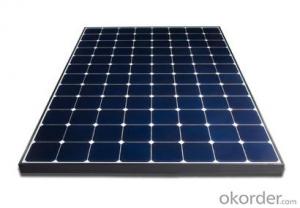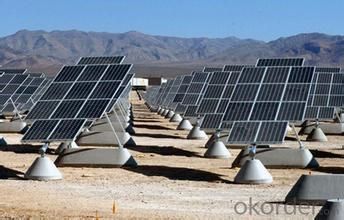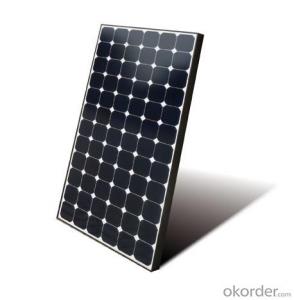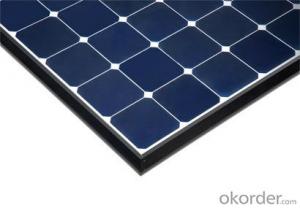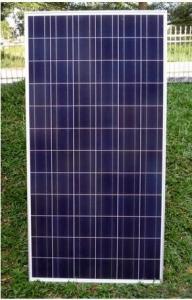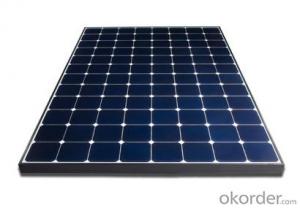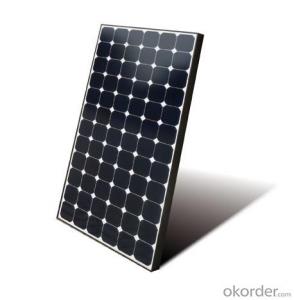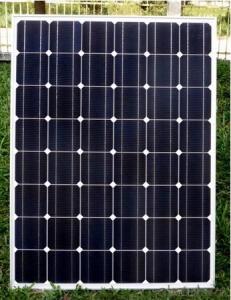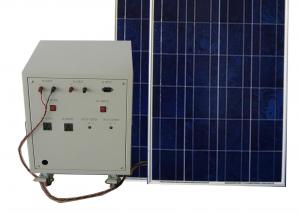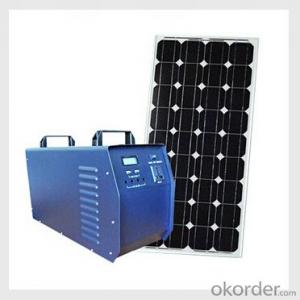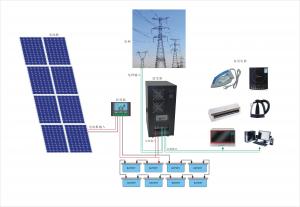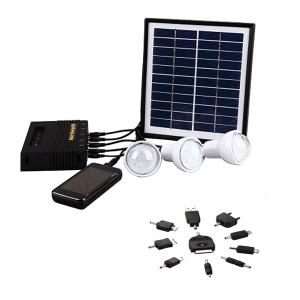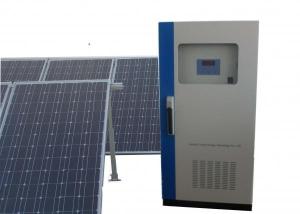Solar Energy Systems Nappanee Indiana - CNBM On Grid System 9000W with Certificate UL TUV CE
- Loading Port:
- Shanghai
- Payment Terms:
- TT OR LC
- Min Order Qty:
- 100 watt
- Supply Capability:
- 1000 watt/month
OKorder Service Pledge
OKorder Financial Service
You Might Also Like
Specification
CNBM On Grid System 9000W with Certificate UL TUV CE
Product description
They range from small residential and commercial rooftop systems to large utility-scale solar power stations. Unlike stand-alone power systems, a grid-connected system rarely includes an integrated battery solution, as they are still very expensive. When conditions are right, the grid-connected PV system supplies the excess power, beyond consumption by the connected load, to the utility grid.
Connection of the photovoltaic power system can be done only through an interconnection agreement between the consumer and the utility company. The agreement details the various safety standards to be followed during the connection.[4]
Electrical connections are made in series to achieve a desired output voltage and/or in parallel to provide a desired current capability. The conducting wires that take the current off the modules may contain silver, copper or other non-magnetic conductive [transition metals]. The cells must be connected electrically to one another and to the rest of the system. Externally, popular terrestrial usage photovoltaic modules use MC3 (older) or MC4 connectors to facilitate easy weatherproof connections to the rest of the system.
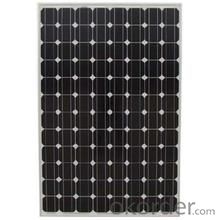
Application
Industrial
Commercial
Residential
Feature
Residential, grid-connected rooftop systems which have a capacity more than 10 kilowatts can meet the load of most consumers.[2] They can feed excess power to the grid where it is consumed by other users. The feedback is done through a meter to monitor power transferred. Photovoltaic wattage may be less than average consumption, in which case the consumer will continue to purchase grid energy, but a lesser amount than previously. If photovoltaic wattage substantially exceeds average consumption, the energy produced by the panels will be much in excess of the demand. In this case, the excess power can yield revenue by selling it to the grid. Depending on their agreement with their local grid energy company, the consumer only needs to pay the cost of electricity consumed less the value of electricity generated. This will be a negative number if more electricity is generated than consumed.[3] Additionally, in some cases, cash incentives are paid from the grid operator to the consumer.
Packaging
With carton and box
- Q: Are there any risks of electrical malfunctions or failures during extreme weather events with solar energy systems?
- Yes, there are some risks of electrical malfunctions or failures during extreme weather events with solar energy systems. While solar panels are designed to withstand various weather conditions, including rain, snow, and wind, they may still be vulnerable to damage in extreme weather events such as hurricanes, tornadoes, or severe storms. High winds can potentially cause physical damage to the solar panels, including dislodging them from their mounts or breaking them entirely. Heavy snowfall can also cover the panels, reducing their efficiency and potentially causing them to collapse under the weight. Additionally, lightning strikes during thunderstorms can pose a risk to the electrical components of the solar energy system, potentially leading to malfunction or failure. However, it is worth noting that solar energy systems are typically built with safety measures in place to minimize these risks. Many solar panels are tested and certified to withstand specific wind speeds and snow loads. Mounting systems are designed to be sturdy and secure, and electrical components often have surge protection to guard against lightning strikes. Moreover, solar energy systems are interconnected with the power grid, allowing for a seamless transition to grid power during extreme weather events if necessary. This can help mitigate the impact of potential malfunctions or failures. To reduce the risks associated with extreme weather events, it is important for solar energy system owners to regularly maintain and inspect their systems. Periodic check-ups and cleaning can help ensure that the panels are in good condition, and any signs of damage or wear can be addressed promptly. It is also advisable to consult with a professional installer or technician who can provide guidance on specific weather-related risks and potential solutions.
- Q: How do solar energy systems impact the reduction of energy transmission losses?
- Solar energy systems help reduce energy transmission losses in multiple ways. First, solar energy systems generate electricity at or near the point of consumption, eliminating the need for long-distance transmission lines. This reduces transmission losses that occur when electricity is transported over extensive distances. Additionally, solar energy systems operate on a decentralized model, meaning they are often installed on rooftops or in close proximity to the consumers. This proximity further reduces transmission losses as the generated electricity does not have to travel far to reach the end-users. Furthermore, solar energy systems convert sunlight directly into electricity without the need for intermediate steps like combustion or steam generation. This direct conversion eliminates the energy losses that occur during these intermediate processes, making solar energy systems more efficient in converting sunlight into usable electricity. Overall, solar energy systems contribute significantly to the reduction of energy transmission losses by generating electricity locally, minimizing the need for long-distance transmission lines, and operating on a direct and efficient conversion process.
- Q: How do solar energy systems affect wildlife and ecosystems?
- Solar energy systems have minimal negative impacts on wildlife and ecosystems compared to other energy sources. While the construction and operation of these systems may disrupt habitats temporarily, they do not emit greenhouse gases or harmful pollutants. Proper planning and implementation can mitigate potential risks, ensuring that solar energy remains a sustainable and environmentally friendly choice.
- Q: What is the role of solar tracking systems in maximizing solar energy capture?
- The role of solar tracking systems in maximizing solar energy capture is to optimize the positioning of solar panels or collectors to track the movement of the sun throughout the day. By continuously adjusting the angle and orientation of the panels, solar tracking systems ensure that they receive maximum sunlight exposure, resulting in enhanced energy generation and improved overall efficiency of solar energy systems.
- Q: Can a solar energy system be installed in a desert environment?
- Solar energy systems can indeed be installed in desert environments. In fact, deserts are considered optimal for solar energy installations due to their ample sunlight and minimal cloud cover. The abundance of solar radiation in deserts makes them exceptionally efficient for generating electricity with solar panels. Additionally, the vast open spaces in deserts offer plenty of land for large-scale solar power plants. Moreover, the arid conditions in deserts contribute to the longevity and durability of solar panels, as they are less susceptible to damage from moisture or extreme weather conditions. All in all, the combination of wide open spaces, high solar radiation, and dry climate render deserts an ideal setting for installing solar energy systems.
- Q: How do solar energy systems impact job creation?
- Solar energy systems have a significant positive impact on job creation. The installation and maintenance of solar panels require skilled workers, leading to the creation of employment opportunities in the renewable energy sector. Additionally, the growth of the solar industry stimulates job creation in related fields such as manufacturing, research, and development. The shift towards solar energy not only contributes to a cleaner environment but also fosters economic growth by generating jobs at various stages of the solar energy supply chain.
- Q: What is the impact of roof pitch on the performance of solar panels?
- The roof pitch, or the angle at which a roof is sloped, has a significant impact on the performance of solar panels. The ideal roof pitch for solar panels depends on various factors, including the geographical location and the desired energy output. One of the primary impacts of roof pitch on solar panel performance is the amount of sunlight that panels receive. The angle of the roof determines how directly sunlight hits the panels. In general, a steeper roof pitch allows for better solar panel performance as it maximizes the sun exposure throughout the day. This is particularly important in areas with lower solar irradiance or during seasons with shorter daylight hours. Another important consideration is the self-cleaning effect of roof pitch. A steeper roof angle facilitates the natural cleaning of solar panels by rainwater, reducing the accumulation of dust, dirt, and debris. This helps maintain the efficiency of the panels over time, as a cleaner surface allows for better light absorption. Furthermore, the roof pitch affects the efficiency of snow shedding. In regions with heavy snowfall, a steeper roof pitch allows snow to slide off more easily, preventing snow accumulation on the panels and ensuring their functionality during winter months. However, it is worth noting that the impact of roof pitch on solar panel performance is not linear. While a steeper roof pitch may offer advantages, there is an optimal angle that maximizes energy production based on the specific latitude of the installation site. This is typically calculated by considering factors such as the sun's angle of incidence and the time of year. In conclusion, the roof pitch plays a crucial role in the performance of solar panels by influencing the amount of sunlight received, facilitating self-cleaning, and aiding snow shedding. Selecting the appropriate roof pitch based on geographic location and energy goals is essential to optimize the efficiency and effectiveness of solar panel installations.
- Q: How do solar energy systems impact the demand for traditional energy sources?
- Traditional energy sources are significantly impacted by solar energy systems, as the installation and integration of solar panels into the power grid decrease reliance on fossil fuels. This occurs because solar energy systems directly generate electricity from sunlight, eliminating the necessity for coal, oil, and natural gas as traditional energy sources. Several factors contribute to the reduced demand for traditional energy sources with the increased adoption of solar energy systems. Firstly, solar power can be produced locally, reducing the need for long-distance electricity transmission from power plants. Consequently, transmission losses and associated costs decrease, rendering solar energy more economically viable. Secondly, solar energy systems generate electricity during daylight hours when demand is typically high, especially in residential and commercial settings. As a result, strain on traditional energy sources during peak demand periods is reduced, assisting in stabilizing the power grid and preventing blackouts or shortages. Additionally, integrating solar energy systems into the power grid allows for excess electricity to be fed back into the grid. This surplus energy can be utilized by other consumers, thereby lowering the overall demand for traditional energy sources. This concept, referred to as net metering, not only diminishes reliance on traditional energy sources but also encourages the adoption of solar energy systems. In conclusion, the widespread use of solar energy systems positively impacts the demand for traditional energy sources. It diminishes the requirement for fossil fuels, promotes energy independence, and contributes to the global transition toward clean and renewable energy sources. However, it is important to acknowledge that replacing traditional energy sources entirely with solar energy is not feasible in all circumstances, and a balanced energy mix remains necessary to meet the diverse energy demands of society.
- Q: What is the difference between on-grid and off-grid solar energy systems?
- On-grid solar energy systems are connected to the local utility grid, allowing excess electricity to be fed back into the grid and enabling the user to draw power from the grid when needed. Off-grid solar energy systems, on the other hand, operate independently and are not connected to the utility grid. They typically rely on batteries to store excess energy for use during times when the sun is not shining.
- Q: How do solar energy systems impact energy conservation efforts?
- Solar energy systems have a significant impact on energy conservation efforts by providing a sustainable and renewable source of power. By harnessing the sun's energy, these systems reduce the reliance on fossil fuels, which helps to mitigate greenhouse gas emissions and combat climate change. Additionally, solar energy systems promote energy independence and decentralization, allowing individuals and communities to generate their own electricity and reduce their dependence on traditional energy grids. Overall, solar energy systems play a crucial role in conserving energy and promoting a greener future.
Send your message to us
Solar Energy Systems Nappanee Indiana - CNBM On Grid System 9000W with Certificate UL TUV CE
- Loading Port:
- Shanghai
- Payment Terms:
- TT OR LC
- Min Order Qty:
- 100 watt
- Supply Capability:
- 1000 watt/month
OKorder Service Pledge
OKorder Financial Service
Similar products
Hot products
Hot Searches
Related keywords
